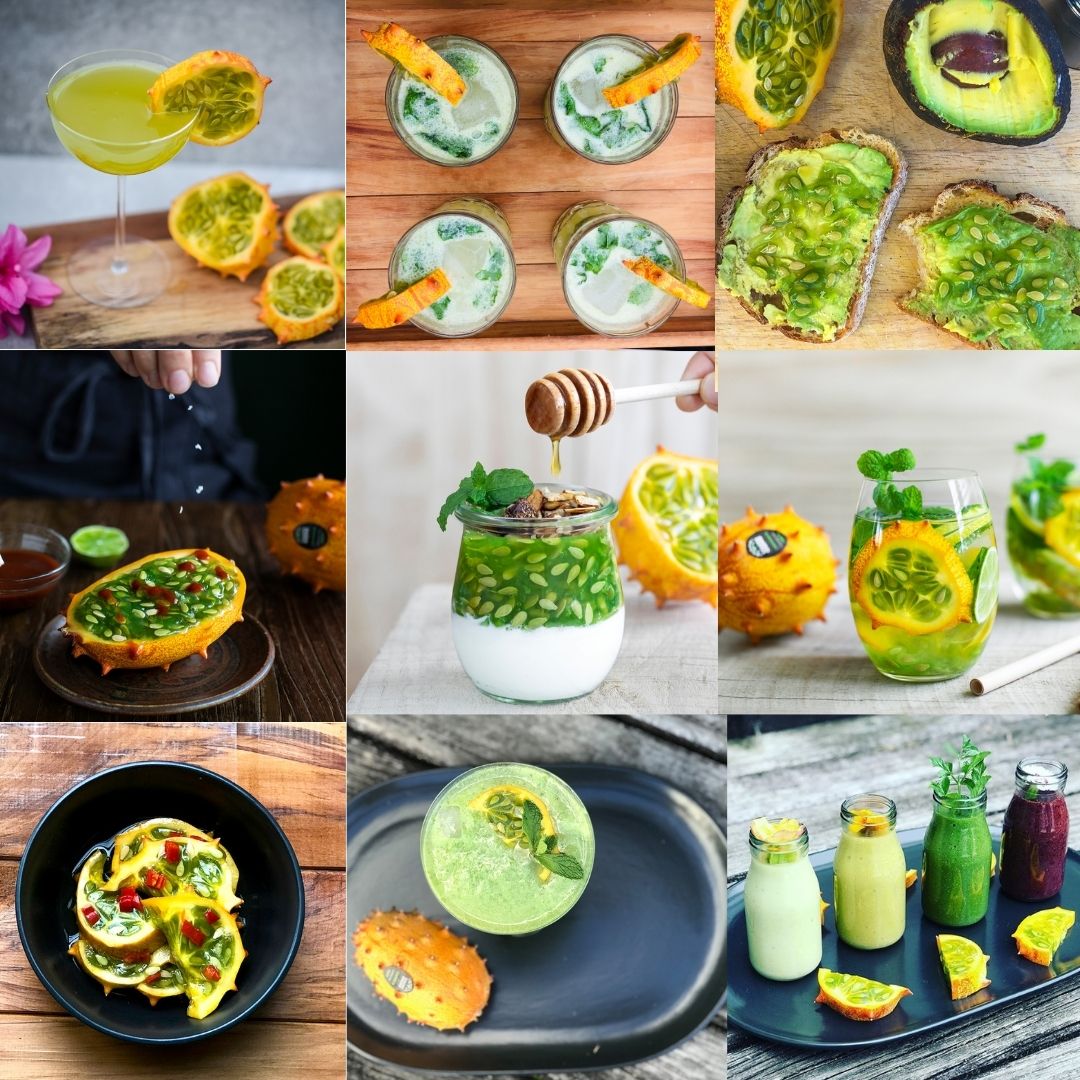
It first caught your eye in the produce section. You were drawn to it’s golden glow and spiky good looks. But then the questions start. Beginning with: what the heck do you do with a this thing?
Surrounded by this amazing fruit every day, there’s not much we don’t know about this spiky orange wonder. Kiwano is an incredibly versatile fruit which is deeply refreshing eaten fresh and also lends itself to savoury options (think salsas, salads, taco toppings and more) as much as traditional fruit uses (smoothies, juices, breakfast bowls, desserts…)
You’ve landed here to find out more about a fruit that we like to say is a little bit different and packed with a whole lot of goodness. So let’s start at the beginning…
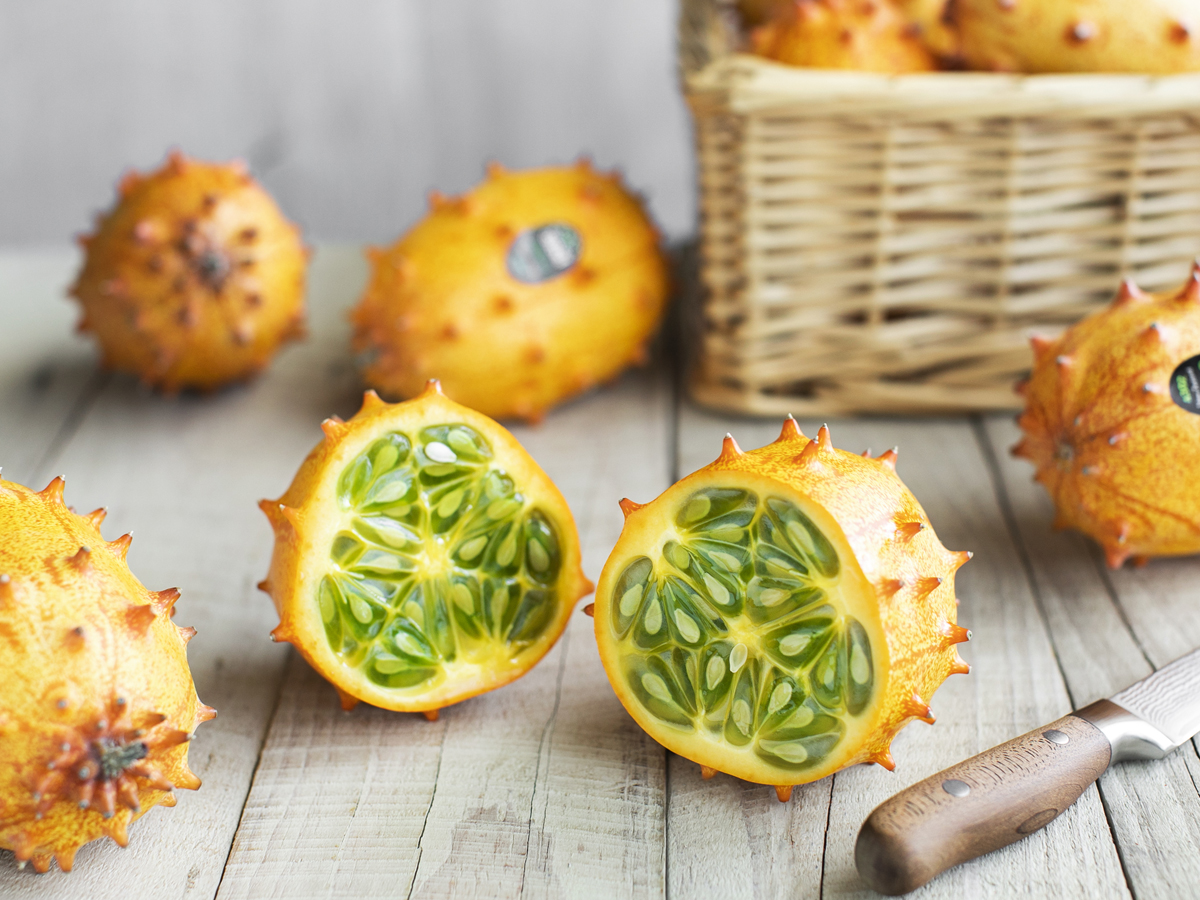
Where are Kiwano from and how do they grow?
Kiwano is an exotic fruit, which grows on a leafy vine along the ground. Originally native to Africa, it is sometimes known as a horned melon or kiwano melon. We dropped the “melon” because (as you’ll soon see) it’s texture and flavour is quite unlike traditional melons such as watermelon or honeydew.
It’s grown commercially mainly in the US and New Zealand. Here in New Zealand we harvest from late January to late April/May (our summer/autumn time).
It needs a warm, mild climate and enough rain to keep the leaf cover healthy. Seedling plants are placed in the ground in the spring. Then, a few weeks later tiny green Kiwano begin to appear. The fruit grow to full size and sun ripen to orange, ready for harvest over the summer months.
Kiwano grow to various sizes – generally you might find them in store ranging in size from a medium avocado to a small eggplant!
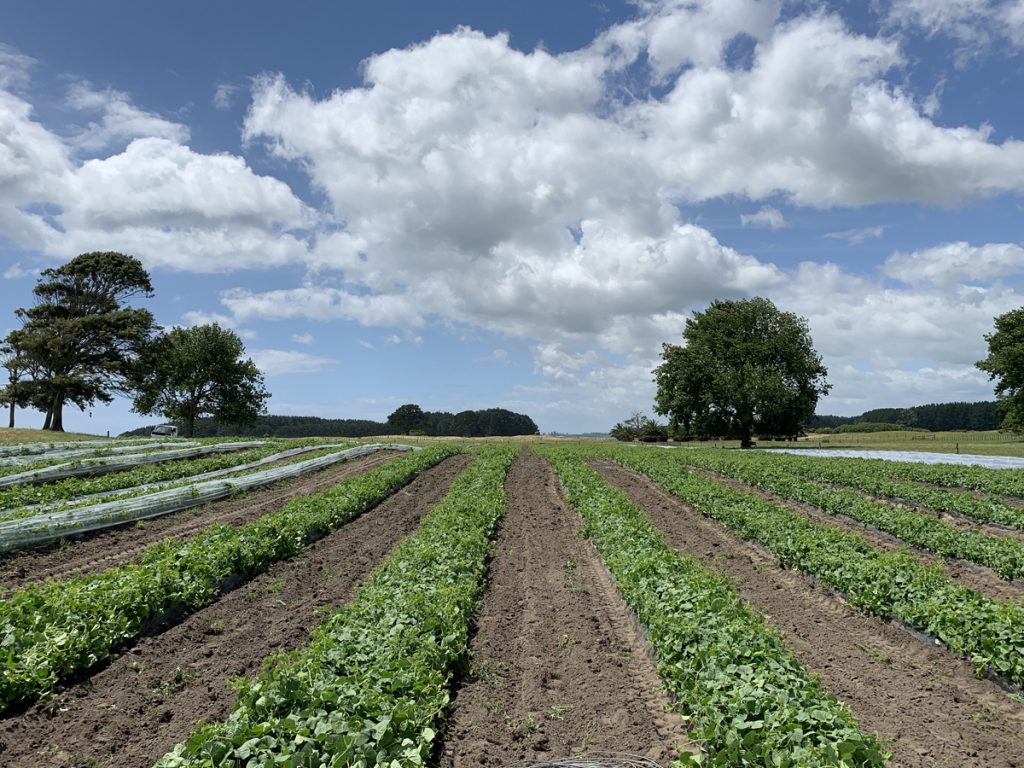
What does a Kiwano taste like?
It’s the million dollar questions and to be honest each person tastes something slightly different! It’s a clean, subtle, refreshingly fruity flavour which after much pondering we describe as a mix of just-ripe banana, passionfruit and lime.
Cutting through the orange skin of a Kiwano reveals a vibrant green pulp inside – this is the part you eat (you can eat the skin but we find it doesn’t have much flavour). If you do want to eat the skin, just use a small sharp knife to cut the small horns off first). Inside its golden-skinned, spiky interior is a vibrant green juicy pulp, with very fine white seeds (which you eat) encased in small jelly globules.
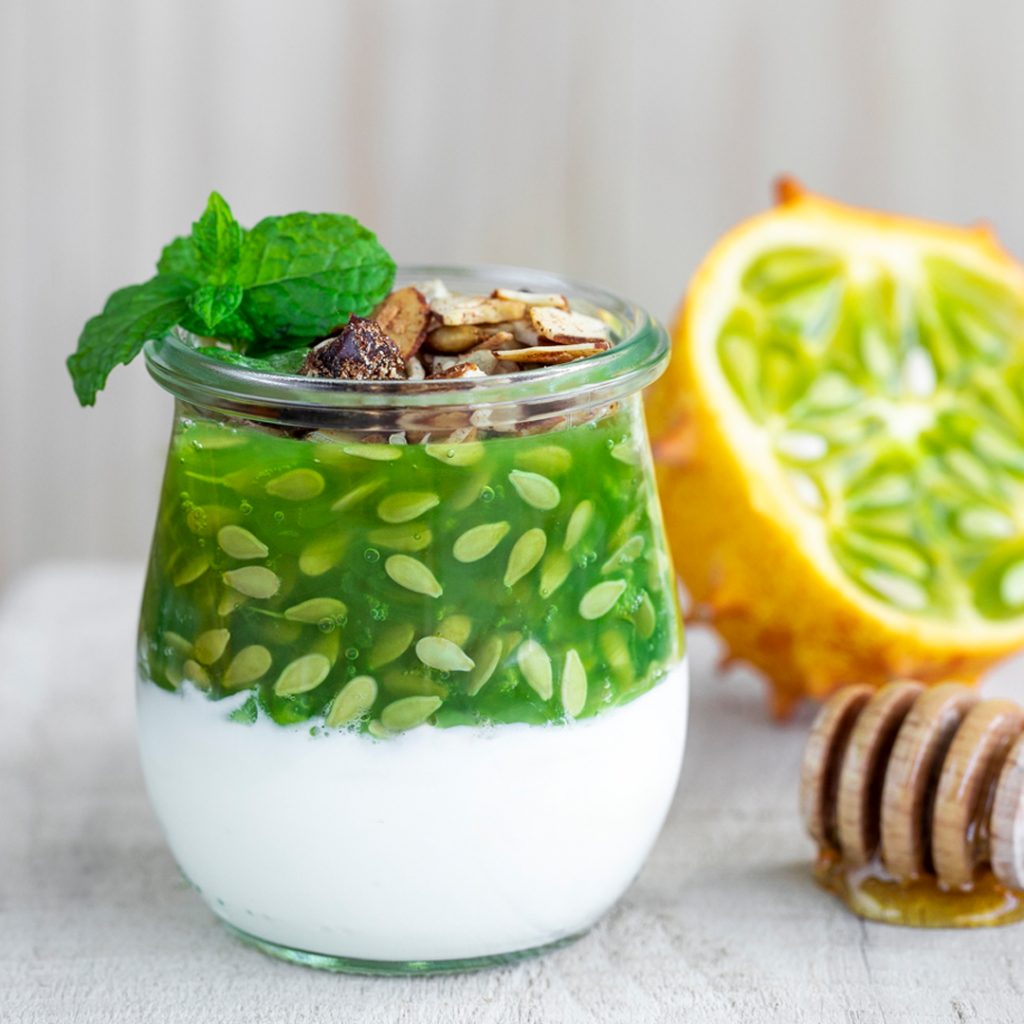
Are Kiwano good for you?
You bet! It has a very low natural sugar content in comparison to other fruits (just 3.8gm per 100gm of fruit), making it a great produce choice for those watching their energy intake.
Kiwano are a source of magnesium, dietary fibre, and potassium. Magnesium is the mega mineral that’s been getting a lot of press lately. Simply put, every cell in your body needs it to function. It helps to keep our teeth and bones strong, reduce tiredness/fatigue, and aid energy metabolism. Potassium is another hard worker. It’s benefits include: keeping a normal water balance in our body, aiding muscle function, and contributing to children’s normal growth and development. Dietary fibre of course is really important for maintaining healthy and regular bowel movements. Read our blog to dig deeper into why each of these nutritional elements are so important.
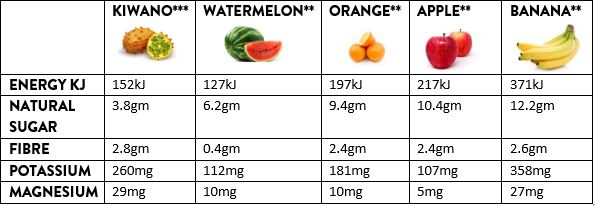
How do you eat Kiwano?
To get the pulp out of your Kiwano first grab a sharp knife and chopping board. Slice your Kiwano in half through the middle. Use the knife to gently “loosen” the pulp away from the skin. Then using two hands, carefully hold the Kiwano between the horns and squeeze the pulp into a small bowl or over the dish you want it in. To eat it fresh you can also scoop out the pulp with a spoon or cut your Kiwano into wedges (and eat it like an orange wedge – just mind the horns!).
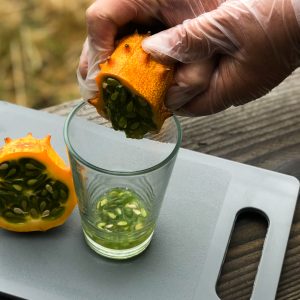
Should I eat the seeds?
You absolutely can and should eat the seeds! Inside the Kiwano’s green pulp are hundreds of slim edible seeds which are encased in the green jelly. These can be strained out if you like, but will change the delicious jelly-like texture. Just give it a try first!
What can you do with Kiwano?
Like it’s exotic friend the pineapple, Kiwano is one of those versatile fruits that can be used in sweet and savoury dishes. Our website has delicious recipes or our Instagram feed is a great place to see how others are using this unique fruit). We highly rate it as a cool, refreshing accompaniment to Asian or Mexican style dishes.
Here’s just a few options:
- In smoothies and juices
- Over ice cream or Greek yogurt
- Mix through fruit salad
- In fresh salsa, raita, and guacamole
- Create cocktails and mocktails
- Dollop on seafood or grilled chicken
- As a healthy taco topping
- Add to salads
- In an exotic breakfast bowl
- Make infused water or as a flavour for iced tea or kombucha

How do I store my Kiwano?
Kiwano don’t like the cold, so keep it out of the fridge! It should be stored at room temperature or above 18 degrees celcius (64F) with plenty of air flow around – your fruit bowl is the perfect spot. Golden rule: Do not refrigerate.
How do I know if my Kiwano is ripe?
A ripe Kiwano will have vibrant orange skin, be shiny and give just a little under pressure. They have an excellent shelf life, so you don’t need to worry about eating it straight away. Just be sure to keep it at room temperature.
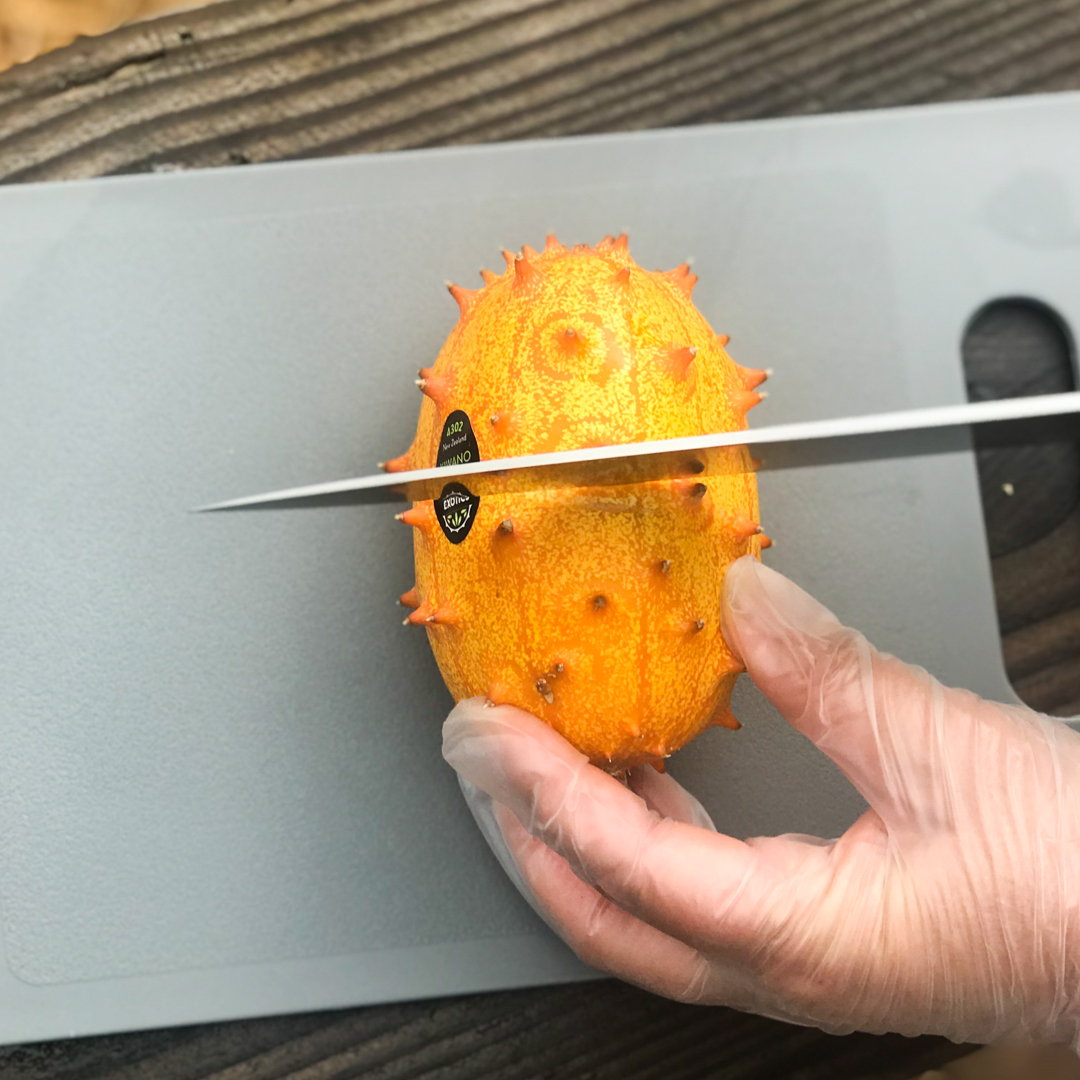
So next time you see one of these golden hued beauties in store, give it a try!
For those of you who have you tried Kiwano, what did you think? We’d love to know.

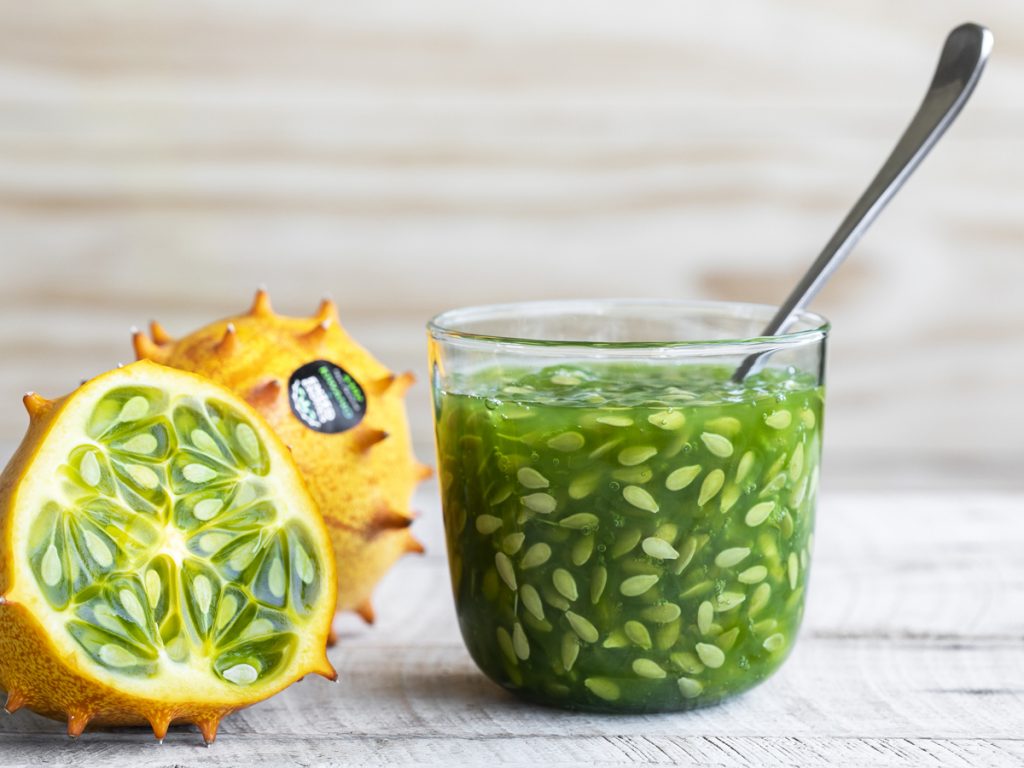
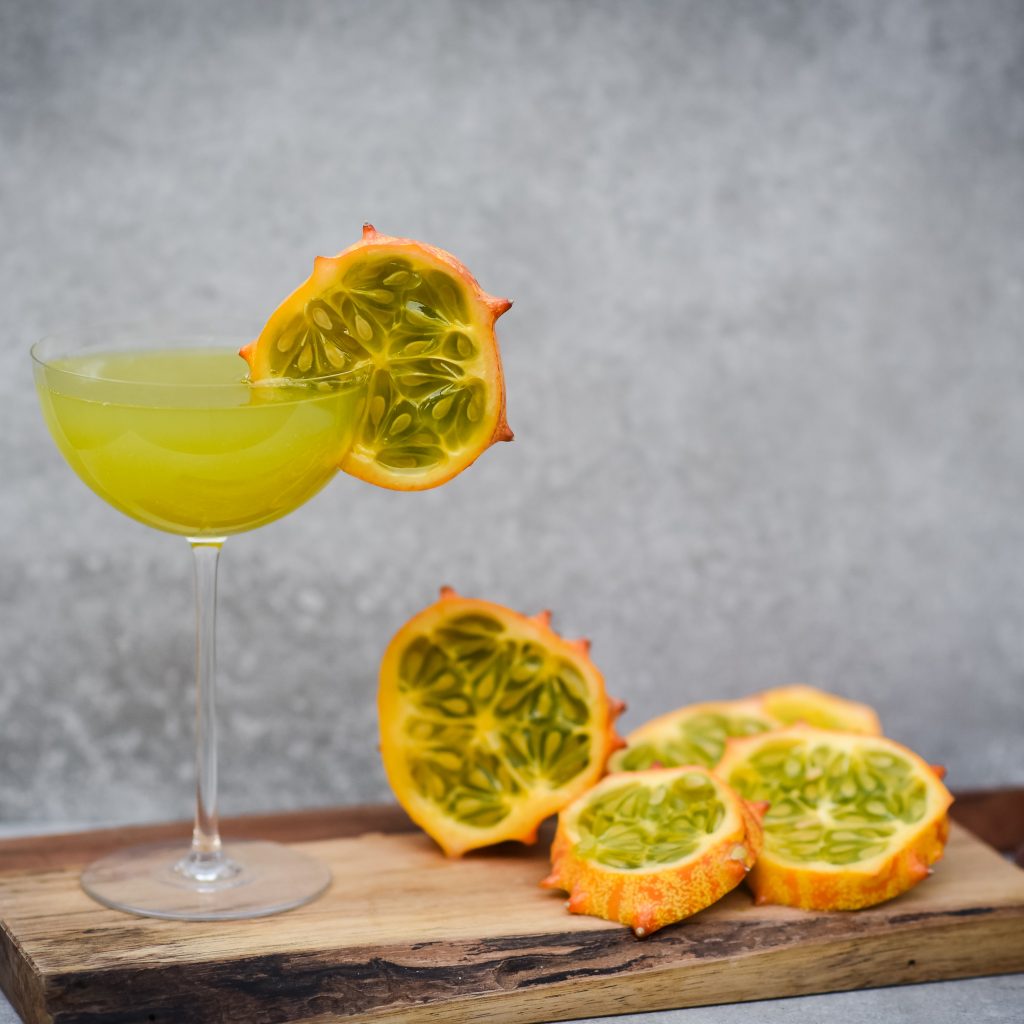



Rita Bateman says:
I am growing a Kiwano in a pot in my greenhouse. I have quite a few small fruits on the plant but l would like to know if I should trim the runners back to the fruit like you do pumpkins or should l just leave it to spread. Hopefully you can help. Thanks in advance.
Ps. First time for growing Kiwano
Enzed Exotics says:
Hi Rita, Our advice would be to let it run as much as you can and then trim it if it starts to take over your greenhouse. It will struggle in a pot – would be better in the ground. Unless of course if the roots have grown out the bottom of the pot and into the ground?
lin deahl says:
Mine has taken over the green house. Grown through the 14 f ft vents, back down the roof and hangs all the way to the ground. it has completely covered the rafters! fruit are set on and hopefully they will have time to ripen. I did trim some ends so I could walk through the aisles. they just branched off and grew more.
Noe says:
I bought a Kiwano a couple years ago, not having ever heard about it, but curious to try new things. The kids and I love them! We saved some of the seeds, and had thrown them out in the garden to try and grow our own, again, not knowing how or what conditions. None sprouted, so the soil went into the compost, but earlier this year I had a plant start growing in a potted tree, it looked like the pumpkins I had started not too long before, so I let it grow, just to see what it would do. Took awhile, and long after the pumpkins had grown and returned to the earth, I saw the first little flowers and tiny Kiwano melon on the vine. Unfortunately most did not make it, I assume the lack of pollinating bees in my area, but one is growing strong! Still green, but it’s getting too cold at night so I plan on picking it and letting it ripen indoors. I’m excited to have grown one without knowing it! And happy the over zealous vine didn’t make my tree too unhappy. Haha
Enzed Exotics says:
Great to hear you love this amazing fruit too! Good luck with your growing.
Stephanie Beard says:
I have several kiwano melon growing wild in my garden. I did NOT plant them. Nor did I plant any other melons from seeds bought in the store. I planted 3 kinds of melons that were from the seeds of fruits I had eaten. I read somewhere that if they are growing wild that they could be poisonous so I’m a little afraid to try them. It is also taking forever for them to turn yellow. If I pick them when they are still green will they continue to ripen inside?
Enzed Exotics says:
Yes Kiwano will continue to ripen but only if the skin is already starting to turn orange. If that’s the case, keep them at room temperature and with plenty of airflow around them. That does seem odd that they are growing when you didn’t plant them. If in doubt of whether it is actually a kiwano probably best not to eat it!
Costin Chiril says:
I found some vines in our bushes, and some of it was on the ground. I found a bright orange, spiky fruit. It’s open and has only it’s seeds left but still looks ripe. PS: the seeds are juicy and red. Should it be like that? Please let me know. Sincerely, Costin Chiril.
Enzed Exotics says:
Hi Costin, no the seeds should be very thin and white – inside a Kiwano should be a vibrant green pulp.
Kimi says:
When growing at home is it best to wait until it’s fully ripe before picking, or to pick when starting to turn and let it ripen off the vine? (I read one source that said it’s sweeter if picked before fully ripe.)
Also, our first fruit (of many) has been orange except for the spikes for 6 weeks now — is it normal for the spikes to take so long to change color?
Also, when/how do you recommend trimming spines ?
Thank you for this site!
Enzed Exotics says:
Hi Kimi,
The spikes on your fruit may not change colour – it still should be perfectly ripe to eat. You can trim the spines off with a sharp knife when you’re ready to eat the fruit – however the most flavour and goodness is found in the bright green pulp inside the Kiwano’s orange skin.
Metti says:
i bought a Kiwano a that was green completely and and put it in a refrigerator for a while and also some days in a room temp, and after 1 month, it is still not completely yellow or orange, maybe about 20 percent still green, what do you recommend to do, thanks.
Enzed Exotics says:
Hi Metti, unfortunately your Kiwano will probably not ripen after being in the fridge – Kiwano do not like the cold so that may have halted the ripening process. Next time you buy one just keep it in an airy spot on the countertop (but out of direct sunlight).
Moana Simm says:
Hi Metti, unfortunately your Kiwano probably wouldn’t have fully ripened as they don’t like to be refrigerated. With ust a few reen patches it is probably fine to eat, give it a try if it doesn’t appear to be ripening any further.
Katlin says:
I bought a Kiwano in the store and outside was mostly orangish yellow but the inside is greenish yellow (not vibrant green), should I have waited for it to ripen more?
Moana Simm says:
Hi Katlin
There can be a variation in colour from lighter green to more vibrant with the fruit pulp, depending on how early it was picked, where it is from etc but if the outside was mostly orangish as you say it should be good to go!
Moana Simm says:
Hi Katlin, the colour can vary from a light green to a very vibrant green – if the outside was and orange/yellow colour it should be fine to eat. The taste of Kiwano is quite subtle and refreshing – it’s not a super sweet fruit (which is why its so good for you and so versatile!).
Lynne Linfield says:
Hi Metti
We have a very healthy, self seeded, (thanks to a bird) in our front garden. We thought it was a cucumber plant at first as it looks exactly the same
We live in SE Queensland.
It has grown vigorously and so fast and looks so healthy! It would have about 50 fruit on it, small and large.
When do we know when the fruit is ready for picking? There are some starting to change to a yellow color but the stalk to the fruit is still very green and thick.
We are looking forward to eating the fruit as we believe it is very good for you.
Moana Simm says:
Hi Lynne, you can start picking the fruit when it is starting to get yellow/orange patches on it – it should then ripen to full orange over the next couple of weeks. Make sure to keep it at room temperature with good air flow around it. You’re right – Kiwano is so great for your health! Visit this page to discover our top 5 health benefits of eating Kiwano https://enzedexoticskiwano.com/kiwano-health-benefits/
Irene says:
I am in Kaitaia in the Far North of NZ – what time of the year would I plant seeds outside please?
Moana Simm says:
Hi Irene, we plant our seedlings in the New Zealand spring, September/October depending on the weather.
Brayden says:
I am growing it currently and we are in frosts at the moment and the plants is thriveing. I have it growing vertically
Moana Simm says:
Good luck with your growing Brayden!
Arpad says:
Hi! Great tips, thank you!
We planted a few kiwanos this year. They “crawled” up as high as 1.5 meters on a metal net and still growing.
I’d like to ask, should fruits hang from the wines or they should be on the ground? It seams to me that a fully developed fruit is too heawy for the thin wines. The first flowers has just appeared near the ground but not near enough …
Thank you in advance!
Moana Simm says:
Hi Arpad, yes you’re right we let the vine run along the ground.
Tyrone says:
I am growing kiwano for the first time and realized the unripe fruit is very similar in taste and texture to a gerkin or pickling cuke. Have you heard of anyone picking them green and pickling them? It seems like a great idea especially with such productive vines…
Moana Simm says:
No, we haven’t tried that before – Let us know how your experiment goes!